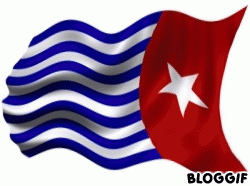
Papuang lives of indigenous poor, destitute, and left. Regional expansion should bear one for the welfare of the people of Papua (Photo: illustration)
One of the effects of Papua became part of the Republic of Indonesia is the Papuan people become marginalized and even strangers on their own land - or at least marginalization process it while it lasted.
Anyone, with a clear conscience and a willingness to adhere to objectivity, would justify this assumption.
But how can we give a rigorous proof and indisputable that the process is actually underway?
Or, perhaps more importantly, what evidence could, even should, be accepted by all parties, including the government of the Republic of Indonesia and its supporters in the international level, that the indigenous people have become alienated in their own land really while it lasted?
The answer is contained in the results of Indonesian Population Census of 2010 (SP-2010). Population census is fully controlled and implemented by the central government agency directly responsible to the President, the Central Statistics Agency (BPS).
In this reform era, we can ensure that the BPS is an independent body that is relatively difficult to be intervened by the government or any parties.
Every 10 years the Census Penduduk.Berbeda BPS conducts the survey, population census data have high validity behavior, because BPS officers visited every household and record the social and economic characteristics of each person in the household.
Results SP-2010 was used also by the UN agencies that take care of the population problem. (Especially with regard to the results of SP-2010 in the province of Papua, visit: <http://papua.bps.go.id/yii/9400/index.php / site / page? view = SP2010>)
According to the SP-2010, the total population of Papua province (not including West Papua) is 2,833,381 inhabitants. Of this amount 76 percent of the population is Papuan People (OAP), while the other 24 percent are migrants.
If we limit ourselves to these figures, it is as if the process of marginalization that did not happen, because the percentage of OAP still dominant compared migran.Benarkah society?
It was not entirely benar.SP-2010 suggest that in the district of Merauke, the percentage of live 37 persen.Di Nabire OAP OAP OAP 48 persen.Di Mimika 41 persen.Di Keerom, as well as in Mimika, OAP also lived 41 percent.
In Jayapura? Even worse than the situation in Merauke, because its amount of OAP living only 35 percent. Who is following - because his OAP's only a 60 per cent? Jayapura and Digoel, and no longer is Sarmi.
Does that mean that in other districts, especially in the Central Highlands region, the position is not threatened OAP?
Let us look at the case of District residents Jayawijaya.Total Jayawijaya according to SP-2010 was 196 085 orang.Sembilan-one percent of them are OAP, while the remainder (9 percent) are the migrants from outside Papua.
Once again, if we stop at these numbers, as if Jayawijaya relatively 'safe' from the invasion of migrants.
But if we look at the situation in Wamena district, especially the village of Wamena town, then the situation is completely different.
According to the SP-2010, the total population of the Village Wamena town is 31 724 people, where is OAP 53.87 percent and 46.11 percent are migrant communities. An amount that does not stick much, and would easily be the same even migrants could be more in the next few years.
There are two important lessons that we can draw from the data results in Papua.Pertama SP-2010, the process of marginalization menjai aka foreigners in their own land was real while it lasted, especially in coastal areas.
In some districts the National Transmigration program targeted in the past (Merauke, Nabire, Mimika, Keerom, Jayapura) OAP has become a minority.
The same thing, although in a relatively slower pace, is also underway in the Central Highlands region and the Southern region of Papua (Merauke minus), as it turned out in the city centers of the district / administration, the percentage of OAP also has begun to diminish.
Can we imagine what will happen when UP4B managed by the program, using the power of forces and Combat Engineers (Zipur) Army to build roads and bridges of the North coast and South coast to the countryside, being offset by the efforts and policies reduce or even stop the entry of migrants?
The answer is clear: fast migrants would 'invade' areas that are now difficult to reach it.
Some readers may ask: what is the situation in West Papua? By normative situation is certainly no different in Papua province, could be even more serious.
It's just not available kuantiatif data to support the normative assumption that, as in West Papua BPS website (<http://irjabar.bps.go.id/>) SP-2010 results did not include data on the Orang Asli Papua.
Unlike the BPS Papua who openly include OAP statistics to be known by the public luas.Pernah a friend of Manokwari NGO officials asking it to Bappeda West Papua, and get the answer, "we have to be careful with the data as it is, because it is very sensitive . "
Hopefully when Dialog Jakarta - Papua held, as a continued effort by friends of the Papua Peace Network, about the marginalization of indigenous Papuans in their own land was also one of the main agenda in the talks.
Because if not, many of OAP will become like his brothers in the capital Merauke Marind society - they have no land at all!
* The author is a social observer, living in Jayapura, Papua







No comments:
Post a Comment